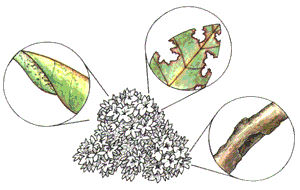 |
| Solving Azalea Problems | |
|---|---|
| Symptoms | Probable Causes |
| Leaf Undersides Spotted | Lacebug |
| Branches Wilted; Holes in Stems | Borers |
| Leaves Yellowed; Veins Green | Iron Chlorosis |
| Leaves and Stems Eaten | Deer Browse |
| Holes Chewed In Leaves | Weevils |
| Plant Parts Skeletonized | Asiatic Garden Beetle |
| Failure to Thrive | Calcium Deficiency |
| Reduced Plant Vigor | Bark Scale |
| Flowers Collapse | Petal Blight |
| Leaves Turn Yellow and Collapse | Wilt |
| Leaves Coated With White Powder | Powdery Mildew |
| Foliage Burned | Dog Urine |
Yellow Leaves and Green Veins Signal Iron Chlorosis
If the soil around your azaleas is not acid enough (pH greater than 5.5), your azaleas may develop an iron deficiency. The chemical environment of the soil blocks the availability of the iron to plant roots. Iron is in the soil, but not in a form that azalea roots can absorb. This is a problem usually with younger, or newly planted azaleas. Iron Chlorosis affects the lower leaves first, turning them yellow but leaving the veins green. The leaves may also be smaller than normal.
While a soil test will confirm the pH, you can usually assume in the absence of any other symptoms that the yellowed leaves are telling the tale. Sprinkle some garden sulfur on the soil at the base of the plant and water it in to correct the soil chemistry. For a quick fix spray foliage with iron sulfate or chelated iron, then fix the soil. Mulching with Canadian sphagnum peat moss and sprinkling used coffee grounds on the soil under the shrub will increase soil acidity over time. Large, well-established azaleas rarely get chlorosis because they are able to influence their soil’s chemistry and assure themselves a proper soil environment.
Holes Chewed In Leaves By Weevils
Black-vined and strawberry root weevil larvae live as grubs, or worms, in the soil over the winter around host plants such as azaleas, rhododendrons, hemlocks and yews. In June they emerge as adult weevils that feed at night on the shrub leaves. Their chew marks make notches in the leaves. They hide in leaf litter during the day so you may never see them. After about a month they lay eggs near the base of their host plant and when they hatch the new larvae burrow into the soil to feed on the plant’s roots. They usually girdle the main trunk just below the soil line, dooming the azalea.
Take control measures as soon as you spot and diagnose the problem. Drench the soil around the afflicted plant with an biological insecticide product containing beneficial nematodes, also called predatory nematodes according to label instructions. Packaged under various brand names, they are in a powder to be mixed with water and poured on the soil. They will enter the soil on the moisture, seek out the grubs and lay their eggs in them, killing them.
For more information see file on Dealing With Weevils
Flowers Collapse Because of Petal Blight
In humid conditions, this fungus peppers azalea blossoms with small white or brown spots. Overnight, flowers collapse into slimy mush. Once plant tissue is infected, it cannot be cured. However, garden sulphur sprayed on unaffected plant leaves and blossoms will control the spread of the fungus to them. Pinch off affected blossoms and discard them in the trash immediately to retard the spread of the fungus to new buds. Because the fungal spores collect on the mulch beneath the shrubs and splash up on them when it rains, removing and discarding the old mulch and replacing it with fresh material may help prevent an repeat outbreak.
For more information see the file on Dealing With Fungal Disease
Foliage Burned From Dog Urine
Dog urine may discolor foliage and even kill branches of azaleas planted along walks and at corners of the yard that are vulnerable to passing male dogs. Spraying foliage with an anti-transpirant spray gives some protection. Screen the plants with low decorative fencing, shade cloth or burlap or spray them with an aerosol pet repellent.
For more information see Dealing With Dogs

